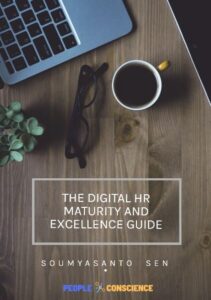Embracing the digital world and implementing technological transformations don’t necessarily begin with technology. They actually begin with a deep change in mindset, an evolution of the way we see the world!
This mindset change entails people becoming more aware of the implications of technology, open-minded to its uses and less entrenched in old, non-digital practices. It’s the evolution to thetech mindsett.

The digital transformation of Human Resources (HR) also follows this path.
It begins with a mindset change or an evolution of understanding and accepting HR technology and, only then, moving on to the deeper levels of know-how and implementation. So, to build digital HR, it’s fundamentally important to break the first and most important barrier: the assumption that the implications of technology won’t affect HR and people’s operations.
What I’m saying is that, even if some HR professionals don’t fully understand the implications and potential uses of game-changing technologies (Artificial Intelligence, Virtual and Augmented Reality, Blockchain, Machine Learning, etc.), it’s vital that they are open-minded towards what’s coming and begin to learn faster.
To put it bluntly, what I’m suggesting is that HR professionals need to leave their assumptions aside and open their minds to agilely learn how technology is disrupting and will continue to disrupt HR operations.
And since the world is experiencing technological change at an exponential pace, the mindset change in HR should also be radical and exponential. The pace of learning should be quick.
I want to propose seven powerful actions to achieve the mindset change needed to embrace and promote the digital transformation of HR.
Walk the walk of diversity: bring technical people onboard
Diversity is not only about gender or ethnicity, but also about a professional background. HR needs to cross-pollinate knowledge with techy people. The digital transformation of HR has a lot to do with bringing people onboard who fully understand the implications of technology and its uses for HR.
I reviewed dozens of HR job postings. Most of them continue to be focused only on HR business acumen, but not on any technological knowledge (not even the basics, such as data analytics).
HR has to leave aside the assumption that only HR people can work in HR. It needs to embrace the idea that programmers, data scientists, engineers and other technical people can and should have a career in HR and become involved with it. By bringing technical people on board, HR will be able to acquire the immense technical expertise to solve people operations’ problems. Bottom line: go back to the drawing board with your HR job postings, because most of them have it all wrong when it comes to the skills for the future!
Familiarize your people with technology (and use it!)
It’s essential that HR professionals are immersed in the definition, implications, and applications of technology. HR can’t be a dead weight for a business that is seeking digital transformation. HR has to be part of that transformation as well. Unfortunately, HR moves way slower than most business functions. And that can have serious costs (including long-term sustainability).

For the digital transformation of HR, as part of the actual technological transformation of any organization, it’s essential that HR professionals familiarize themselves with technology. I’m not suggesting that they become programmers or AI-experts. Instead, I’m proposing that they have the opportunity to be exposed to technology (either informal or on-the-job training or by being assigned to projects with tech implications).
Build an innovation and technology core team
Sad news: bringing in tech people and knowing about HR technology is not enough. Why? Simply because the world is changing extremely fast. Creating an innovation and tech core team is very useful for staying up to date.
The basic building blocks of this core team are diversity, agility and close collaboration. Such a team needs people from various backgrounds: HR, tech, policy, innovation, etc. The more diverse the team the more able they will be to complement each other in their knowledge and skills. By the way, the core team wouldn’t be exclusively working in innovation and tech, as I know that HR always has budget constraints making them be as lean as possible. Nevertheless, it will be at the forefront of research, experimentation, and innovation within HR. It’s the idea laboratory of HR. It is the “Google X” of HR!
Leave assumptions and preconceptions aside
I’ve already said this. Many HR professionals are unfortunately entrenched in the old ways. They think of performance management, career progression, promotions, sourcing and recruitment, innovation, partnering, talent management or training using the old-fashioned and out-of-date methods. What’s worse, when a new innovative solution is proposed, those old-HR thinkers disregard it, not because of its nature, but in the light of what they are used to doing since the beginning of time!
Leaving assumptions and preconception aside is critical for the digital transformation of HR. It’s absolutely impossible to embrace technology and the digital world when people come with negative or limiting assumptions about their potential benefits. In short, my fundamental suggestion here is to remain open-minded to technology. I can also put it more frankly: HR professionals who don’t open their minds to the technological transformation of their role will be steam-rolled by those who do.
Promote internal mobility
Every 2 days we create as much information as we did in all our human history before 2003. It’s impossible for any single individual or small team to know or learn everything. It doesn’t even matter how small a niche is; there sure is a lot of information about it. Thus, my recommendation is to create a flexible approach that allows for mobility every 2 to 4 years (if not less). Make the mobility process seamless!

Promoting internal mobility within HR boundaries and with other tech teams in the company allows:
1) cross-pollination of ideas between seemingly different teams and areas of knowledge;
2) keeping the workforce engaged and continually challenged to learn more;
3) exposing HR professionals to the day-to-day business operation, as well as to the latest developments in areas other than their own.
Ultimately, mobility brings good results, ideas, learning, failures, and successes from one team to another. Therefore, spreading technical knowledge across HR and the entire organization.
Looking for best practices? They are obsolete by the time you find them!
Nobody knows for sure, but it seems that Henry Ford said, “If I had asked people what they wanted, they would have said faster horses.” Evidently, the “best practice” for transportation was horses, not cars.
HR professionals are always hungry for best practices. I’m not going to underestimate the value that researching best practices once had. Unfortunately, in today’s exponentially changing world, it’s extremely challenging to know what is or what isn’t a good practice. Technology is changing everything so fast that there’s almost no time to find out what a best practice is. And if you do find it, by the time you have, it’s already obsolete.
Instead of best practices, it’s much more relevant to keep a few principles in mind:
1) experiment at a small scale;
2) evaluate results and scale if the experiments are successful;
3) remain agile by learning fast from failure and successes;
4) don’t dwell or punish failure—instead, get the most out of it and move on;
5) technology is the tool, but HR is still centered on people—don’t forget that!—; and
6) keep the HR people and teams professionally challenged and engaged.
Raise the bar and set interesting goals. Especially the ones needed for the digital transformation of HR.
This article has been written by Enrique Rubio, he is an HR Specialist at Inter-American Development Bank and originally published in WISP blog.


